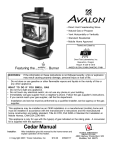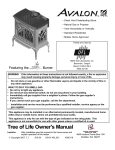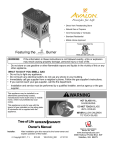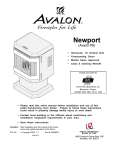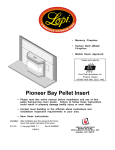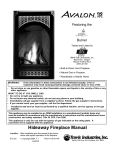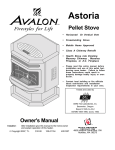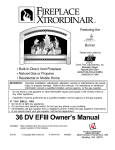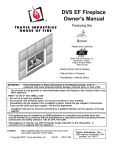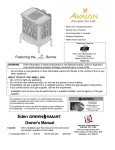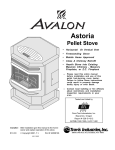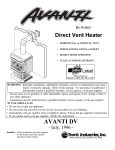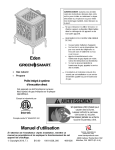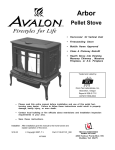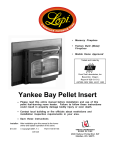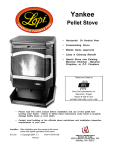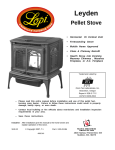Download Lopi Direct Vent Freestanding Stove Stove User Manual
Transcript
• Direct Vent Freestanding Stove
• Natural Gas or Propane
• Vent Horizontally or Vertically
• Standard Residential
• Mobile Home Approved
Tested and Listed by
Featuring the
WARNING:
-
•
•
•
•
-
Burner
OMNI-Test Laboratories, Inc.
Beaverton, Oregon
Report # 028–S–50-5
ANSI Z21.88
If the information in these instructions is not followed exactly, a fire or
explosion may result causing property damage, personal injury or loss of life.
Do not store or use gasoline or other flammable vapors and liquids in the vicinity of this or any
other appliance.
WHAT TO DO IF YOU SMELL GAS
Do not try to light any appliance.
Do not touch any electrical switch; do not use any phone in your building.
Immediately call gas supplier from a neighbor's phone. Follow the gas supplier's instructions.
If you cannot reach your gas supplier, call the fire department.
Inst allat ion and service must be performed by a qualified inst aller, service agency or t he gas
supplier.
This appliance may be installed as an OEM installation in a manufactured (mobile) home and
must be installed in accordance with the manufacturer’s instructions and the manufactured home
construction and safety standard, Title 24 CFR, Part 3280.
This appliance is only for use with the type(s) of gas indicated on the rating plate. A
conversion kit is supplied with the appliance.
Sturbridge Owner’s Manual
Installer: After installation give this manual to the homeowner and explain operation of this heater.
$10.00
Copyright 2007, T.I.
Part # 100-01142
Travis Industries, Inc.
4800 Harbour Pointe Blvd. SW
Mukilteo, WA 98275
Introduction
2
Introduction
We welcome you as a new owner of a Lopi Sturbridge stove. In purchasing a Sturbridge you have
joined the growing ranks of concerned individuals whose selection of an energy system reflects both
a concern for the environment and aesthetics. The Sturbridge is one of the finest home heaters the
world over. This manual will explain the installation, operation, and maintenance of this stove. Please
familiarize yourself with the Owner's Manual before operating your heater and save the manual for
future reference. Included are helpful hints and suggestions that will make the operation and
maintenance of your new stove an easier and more enjoyable experience. We offer our continual
support and guidance to help you achieve the maximum benefit and enjoyment from your heater.
Important Information
No other Sturbridge Stove has the same serial number
as yours. The serial number is on the listing plate
chained to the gas control valve.
This serial number will be needed in case you require
service of any type.
Model:
Serial Number:
Purchase Date:
Purchased From:
Travis Industries
Lopi Sturbridge Stove
Mail your Warranty Card
Today, and Save Your Bill of
Sale.
To receive full warranty coverage,
you will need to show evidence of
the date you purchased your
heater. Do not mail your Bill of
Sale to us.
We suggest that you attach your
Bill of Sale to this page so that you
will have all the information you
need in one place should the need
for service or information occur.
100-01142
4050114
Table of Contents
Introduction
3
Operation
Introduction & Important Information................2
Before You Begin .........................................22
Location of Controls .....................................22
Safety Precautions
Safety Precautions ......................................4
Specifications
Starting The Pilot .........................................23
Starting the Stove for the First Time .................24
Turning the Stove On and Off .........................24
Features ....................................................6
Adjusting the Flame Height.............................24
Installation Options ......................................6
Adjusting the Blower Speed (optional) ..............25
Heating Specifications ..................................6
Normal Operating Sounds ..............................25
Dimensions.................................................6
Normal Operating Odors ................................25
Installation
Maintenance
Installation Warning......................................7
Maintaining Your Stove’s Appearance ..............26
Packing List................................................7
Yearly Service Procedure ..............................26
Additional Items Required for Installation ..........7
Troubleshooting Table...................................27
Installation Overview ....................................7
How this Stove Works ...................................28
Installation Hints..........................................8
What Turns the Main Burners On and Off......28
Stove Clearances ........................................8
Mobile Home Requirements ............................8
Heater Placement Requirements .....................9
What Prevents Gas Buildup.......................28
Wiring Diagram ............................................29
Replacement Parts List .................................29
Floor Protection Requirements........................9
Gas Line Installation.....................................10
Vent Requirements.......................................11
Approved Vent Configurations ........................12
Diffuser Plate Removal .............................12
Restrictor Position...................................12
Measuring Vent Lengths ...........................13
Approved Vent Config’s Horizontal Term. .....14
Approved Vent Config’s Vertical Term..........15
Vent Termination Requirements ......................16
Safety Label
Safety (Listing) Label....................................30
Warranty
Warranty ....................................................31
Optional Equipment
Optional Accessories ...................................32
LP Conversion Kit ........................................33
Blower .......................................................36
Fireback.....................................................38
Finalizing the Installation
Leak Test ...................................................17
Pilot Adjustment (if necessary) .......................17
Stone Inserts ..............................................39
Installation Addenda
Air Shutter Adjustment (if necessary)...............17
Class A Chimney Conversion..........................40
Check Flame ...............................................18
Interior Masonry Chimney Conversion ..............41
Glass Removal (& installation) ........................19
Log Installation............................................21
Index
Index.........................................................42
Travis Industries
100-01142
4050114
Safety Precautions
4
• IF YOU SMELL GAS:
*
*
*
*
*
Do not light any appliance
Extinguish any open flame
Do not touch any electrical switch or plug or unplug anything
Open windows and vacate building
Call gas supplier from neighbor's house, if not reached, call fire
department
•
This unit must be installed by a qualified installer to prevent the
possibility of an explosion. Your dealer will know the requirements in
your area and can inform you of those people considered qualified.
The room heater should be inspected before use and at least annually
by a qualified service person. More frequent cleaning may be
required due to excessive lint from carpeting, bedding material, etc.
•
The instructions in this manual must be strictly adhered to. Do not use makeshift
methods or compromise in the installation. Improper installation will void the warranty
and safety listing.
Look for this label:
•
For LPG only | Pout 11” W.C.
If the label is present, the
heater is equipped for LP
(propane). If the label is
absent, the heater is equipped
for NG (natural gas).
This heater is either approved for natural
gas (NG) or for propane (LP or LPG).
Burning the incorrect fuel will void the
warranty and safety listing and may cause
an extreme safety hazard. Direct
questions about the type of fuel used to
your dealer. Check for the label shown to
the right.
•
Contact your local building
officials to obtain a permit
and information on any
installation restrictions or
inspection requirements in
your area. Notify your
insurance company of this
heater as well.
• If the flame becomes sooty,
dark orange in color, or
extremely tall, do not
operate the heater. Call
your dealer and arrange for
proper servicing.
•
It is imperative that control
compartments, screens, or
circulating air passageways
of the heater be kept clean
and free of obstructions.
These areas provide the air
necessary for safe
operation.
• Do not operate the heater if
it is not operating properly in
any fashion or if you are
uncertain. Call your dealer
for a full explanation of your
heater and what to expect.
Ok
•
Gas
Travis Industries
Do not store or use gasoline
or other flammable liquids in
the vicinity of this heater.
?
AAAA
A
AAAA
100-01142
• Do not use this appliance if
any part has been under
water. Immediately call a
qualified service technician
to inspect the appliance and
to replace any part of the
control system and any gas
control which has been
under water.
4050114
Safety Precautions
•
•
•
•
A
A
AA
AA
AA
AA
A
Do not place clothing or
other flammable items on or
near the heater. Because
this heater can be controlled
by a thermostat there is a
possibility of the heater
turning on and igniting any
items placed on or near it.
• Light the heater using the
built-in piezo igniter. Do not
use matches or any other
external device to light your
heater.
The viewing glass should be
opened only for lighting the
pilot or conducting service.
Any safety screen or guard
removed for servicing must
be replaced prior to
operating the heater.
Do not operate with the
glass removed or damaged.
instructions are given in this
manual. All other work must
be done by a trained
technician. Don't modify or
replace orifices.
•
Operate the heater
according to the instructions
included in this manual.
•
If the main burners do not
start correctly turn the gas
off at the gas control valve
and call your dealer for
service.
•
This unit is not for use with
solid fuel
•
Do not place anything inside
the firebox (except the
included fiber logs).
•
If the fiber logs become
damaged, replace with
Travis Industries log set.
•
Children and adults should
be alerted to the hazards of
high surface temperature
and should stay away to
avoid burns or clothing
ignition. Young children
should be supervised when
they are in the same room as
the heater.
•
Travis Industries
5
Instruct everyone in the
house how to shut gas off to
the appliance and at the gas
main shutoff valve. The gas
main shutoff valve is usually
next to the gas meter or
propane tank and requires a
wrench to shut off.
100-01142
• Never remove, replace,
modify or substitute any part
of the heater unless
• Allow the heater to cool
before carrying out any
maintenance or cleaning.
• The pilot flame must contact
the thermopile and
thermocouple (see the
illustration to the left). If it
does not, turn the gas
control valve to "OFF" and
call your dealer.
• Do not throw this manual
away. This manual has
important operating and
maintenance instructions
that you will need at a later
time. Always follow the
instructions in this manual.
This
Manual
•
Plug the heater into a
120V grounded electrical
outlet. Do not remove the
grounding plug.
•
Don’t route the electrical
cord in front of, over, or
under the heater
• Travis Industries, Inc.
grants no warranty,
implied or stated, for
the installation or
maintenance of your
heater, and assumes
no responsibility of any
consequential
damage(s).
4050114
Specifications
6
Features:
-
Installation Options:
Ember Fyre™ Burner for "Wood Fire" Look
Works During Power Outages (millivolt system)
High Efficiency
Optional Thermostat or Remote Control
Optional Blower for Quicker Heat Distribution
Convenient Operating Controls
Variable-Rate Heat Output
Low Maintenance
-
Freestanding Stove
-
Horizontal or Vertical Vent
-
Residential or Mobile Home
-
Straight or Corner Placement
-
Bedroom Approved
Heating Specifications:
Approximate Heating Capacity (in square feet)*............up to 850 with Blower, up to 650 Without
Maximum Input (in BTU’s) .........................................................................18,000
Minimum Output On Low (in BTU’s)...........................................................9,900
Steady State Efficiency............................................................................up to 80.1%
AFUE (without blower) .............................................................................Up to 67.8%
•
**
Heating capacity will vary depending on the home’s floor plan, degree of insulation, and the outside
temperature.
Efficiency rating is a product of thermal efficiency rating determined under continuous operation independent
of installed system.
Dimensions & Weight:
NOTE:
The flue collar protrudes 2-7/8"
Measure side, corner,
behind the stove top
and back clearances
from the stove top.
20-3/4"
14"
18-1/2"
24-1/2"
Weight: 130 Lbs.
Electrical Specifications (for optional blower)
Electrical Rating.........................................................115 Volts, 1.3 Amps, 60 Hz (150 watts on high)
Fuel:
This heater is shipped in natural gas (NG) configuration but may be converted to propane (LP) using
the included LP conversion kit. The sticker on top of the gas control valve will verify the correct fuel.
Travis Industries
100-01142
4050114
Installation
7
(for qualified installers only)
Installation Warnings:
!
!
!
!
!
!
!
!
Failure to follow all of the requirements may result in property damage, bodily
injury, or even death.
This heater must be installed by a qualified installer who has gone through a
training program for the installation of direct vent gas appliances.
This appliance must be installed in accordance with all local codes, if any; if not, in
U.S.A. follow ANSI Z223.1 and NFPA 54(88).
In Manufactured or Mobile Homes must conform with Manufactured Home
Construction and Safety Standard, Title 24 CFR, Part 3280, or, when such a
standard is not applicable, the Standard for Manufactured Home Installations,
ANSI/NCSBCS A225.1. This appliance may be installed in Manufactured Housing
only after the home is site located.
This stove is designed to operate on natural gas or propane (LP).
All exhaust gases must be vented outside the structure of the living-area.
Combustion air is drawn from outside the living-area structure.
Notify your insurance company before hooking up this stove.
The requirements listed below are divided into sections. All requirements must be
met simultaneously. The order of installation is not rigid – the qualified installer
should follow the procedure best suited for the installation.
Packing List
•
•
•
•
•
•
•
Additional Items Required
Propane Conversion Kit
•
Log Set
•
2” Pipe, 8” Pipe, and 90° Elbow (for gas inlet)
Door Latch Tool (to un-latch glass frame)
Touch-Up Paint
Side Insert Retainers (for models shipped without inserts)
Cover Plate with Knob (for the Aroma-Therapy option)
Vent (see “Venting Requirements” for details)
Gas Line Equipment (shutoff valve, pipe, etc.)
Installation Overview
AAAAAAAAAAAAAAAAAA
AAAAAAAAAAAAAAAAAAA
AAAAAAAAAAAAAAAAAA
AAAAAAAAAAAAAAAAAAA
AAAAAAAAAAAAAAAAAA
AAAAAAAAAAAAAAAAAAA
AAAAAAAAAAAAAAAAAAA
AAAAAAAAAAAAAAAAAA
See
"Vent
AAAAAAAAAAAAAAAAAA
AAAAAAAAAAAAAAAAAAA
See
Requirements"
AAAAAAAAAAAAAAAAAA
AAAAAAAAAAAAAAAAAAA
"Clearances"
AAAAAAAAAAAAAAAAAA
AAAAAAAAAAAAAAAAAAA
AAAAAAAAAAAAAAAAAA
AAAAAAAAAAAAAAAAAAA
AAAAAAAAAAAAAAAAAA
AAAAAAAAAAAAAAAAAAA
See
"Gas
Line
AAAAAAAAAAAAAAAAAA
AAAAAAAAAAAAAAAAAAA
Installation"
AAAAAAAAAAAAAAAAAA
AAAAAAAAAAAAAAAAAAA
AAAAAAAAAAAAAAAAAA
AAAAAAAAAAAAAAAAAAA
AAAAAAAAAAAAAAAAAA
AAAAAAAAAAAAAAAAAAA
AAAAAAAAAAAAAAAAAA
AAAAAAAAAAAAAAAAAAA
AAAAAAAAAAAAAAAAAA
AAAAAAAAAAAAAAAAAAA
AAAAAAAAAAAAAAAAAA
AAAAAAAAAAAAAAAAAAA
AAAAAAAAAAAAAAAAAAA
AAAAAAAAAAAAAAAAAA
AAAAAAAAAAAAA
AAAAAAAAAAAAAAAAAA
AAAAAAAAAAAAAAAAAAA
AAAAAAAAAAAAA
AAAAAAAAAAAAAAAAAA
AAAAAAAAAAAAAAAAAAA
AAAAAAAAAAAAA
See "Floor
AAAAAAAAAAAAAAAAAA
AAAAAAAAAAAAAAAAAAA
AAAAAAAAAAAAA
Protection
AAAAAAAAAAAAAAAAAA
AAAAAAAAAAAAAAAAAAA
AAAAAAAAAAAAA
Requirements"
AAAAAAAAAAAAAAAAAA
AAAAAAAAAAAAAAAAAAA
AAAAAAAAAAAAA
AAAAAAAAAAAAAAAAAAA
AAAAAAAAAAAAA
AAAAAAAAAAAAA
Travis Industries
100-01142
4050114
Installation
8
(for qualified installers only)
Installation Hints:
•
If converting to LP, convert the appliance prior to installation.
•
The blower is easiest to install prior to installation. Because the blower is located near the gas inlet
location, we recommend using the included pipe and elbow to route the gas inlet around the blower
position.
•
Install the logs last - they are fragile.
•
When determining the location of the stove, locate the wall studs (for horizontal penetrations) and
ceiling trusses (for vertical penetrations). You may wish to adjust the stove position slightly to ensure
the vent does not intersect with a framing member.
•
Fumes and smoke from the paint curing and oil burning off the steel may occur the first time you start
this heater. This is normal. We recommend you open windows to vent the room.
Stove Clearances
Straight Installations
Corner Installations
3-1/2" Min.
4-3/4" Min.
AA
AA
AA
1" Min.
1" Min.
45°
Mobile Home Requirements
•
When the stove is installed in a mobile home, it must be bolted to the floor.
•
When the optional blower is installed it must be connected to a properly grounded three-prong
receptacle. Do not cut or remove the grounding prong from the optional blower cord.
Travis Industries
100-01142
4050114
Installation
9
(for qualified installers only)
Heater Placement Requirements
•
Heater must be installed on a level surface capable of supporting the heater and vent
•
Due to the high temperature, the heater should be located out of traffic and away from
furniture and draperies.
•
When placed in a location where the floor to ceiling height is under 7 feet, the installation
is considered an alcove and must meet the following requirements:
•
The alcove floor to ceiling height must be at least 36” tall
•
The alcove must not be more than 48” deep before the ceiling returns to 7’
•
The alcove must be at least 27-3/4” wide
•
The heater must not be placed so the vents below or above the door, along the sides of
heater, or along the back of the heater can become blocked.
This heater may be placed in a bedroom. Please be aware of the large amount of heat this
appliance produces when determining a location.
•
Floor Protection Requirements
•
When the stove is installed directly on carpeting, vinyl or other combustible material other
than wood flooring or a high pressure laminate wood floor, the stove must be installed on
a metal or wood protection panel extending the full width and depth of the stove top
(Minimum 20-3/4” wide by 14” deep).
Make sure these rubber tipped
bolts on each leg contact the floor
(they dampen any noise that may
transmit through the hearth). Do
not adjust with weight on the legs,
the rubber tips may tear.
Travis Industries
100-01142
4050114
Installation
10
(for qualified installers only)
Gas Line Installation
!
The gas line must be installed in accordance with all local codes, if any; if not, follow current ANSI
Z223.1 or NFPA 54.
!
The heater and gas control valve must be disconnected from the gas supply piping during any
pressure testing of that system at test pressures in excess of 1/2 psig (3.45 kPA). For pressures
under 1/2 psig (3.45 kPA), isolate the gas supply piping by closing the manual shutoff valve.
•
This heater is designed for natural gas but can be converted to propane. Check the sticker on
top of the gas control valve to verify the correct fuel is used (see page 4).
•
Leak test all gas line joints and the gas control valve prior to and after starting the heater.
•
The gas inlet accepts a 3/8” F.P.T. Fitting
•
The location of the gas inlet is shown below
•
A manual shutoff valve is required for installation (it must be located within 3’ of the heater). THandle gas cocks are required in Massachusetts in compliance with code 248CMR.
•
Installation must be performed by a qualified installer, service agency or the gas supplier (In
Massachusetts a licensed plumber/gasfitter).
With the included pipe
installed, the gas inlet is
located at the location
shown below.
C
te
en
rlin
e
7-5/8"
A
17-1/2"
4-3/8"
Gas Inlet Pressure
•
With the heater off, the inlet pressure must meet the requirements listed in the table below
•
If the pressure is not sufficient, make sure the piping used is large enough and the total gas load
for the residence does not exceed the amount supplied.
•
The supply regulator (the regulator that attaches directly to the residence inlet or to the propane
tank) should supply gas at the suggested input pressure listed below. Contact the local gas
supplier if the regulator is at an improper pressure.
Natural Gas
Propane
Travis Industries
Standard Input Pressure
7” W.C. (1.74 Kpa)
13” W.C. (3.23 Kpa)
100-01142
4050114
Installation
11
(for qualified installers only)
Vent Requirements
!
Always maintain the required 1” clearance (air space) to combustible materials to prevent a fire hazard.
Do not fill air spaces with insulation.
!
The gas appliance and vent system must be vented directly to the outside of the building, and never
be attached to a chimney serving a separate solid fuel or gas-burning appliance. Each direct vent gas
appliance must use it’s own separate vent system.
• This appliance is equipped only for
altitudes 0-2000 feet. However,
our in-house testing has shown
that the unit operated at altitudes to
8000 ft.
!
•
•
Vertical Termination NOTE: always
use the "high-wind" version (if
applicable)
Vertical Vent
Requirements
Use a roof flashing and storm collar
whenever passing through the roof
Failure to adjust the air shutter
properly may lead to improper
combustion which can create a
safety hazard. Consult your dealer
or installer if you suspect an
improperly adjusted air shutter.
Use a firestop spacer whenever
passing through a ceiling
Minimum framing
for fire stop
8-5/8"
When the vent passes through a
wall, a wall thimble is required.
When the vent passes through a
ceiling, a support box or firestop is
required. When the vent passes
through the roof, a roof flashing
and storm collar are required.
Follow the instructions provided
with the vent for installing these
items.
Maintain a minimum 1"
clearance from vent to
any combustible
Use a support box
on exposed vent
Use a firestop whenever
passing through a wall
Horizontal Vent
Requirements
8-5/8"
Minimum
Framing for
wall thimble
Maintain a minimum 1"
clearance from vent to any
combustible.
Horizontal Termination
Use of of the following 6-5/8" diameter co-axial gas direct vent systems:
Manuafacturer
Series
Simpson Dura-Vent
Model GS
Selkirk Hearth Products
Direct-Temp
American Metal Products
Ameri-Vent
Metal-Fab Inc.
Direct-Vent with 4DHT or 4DVT Cap
N O T E: Always use the high-wind cap for the type of vent you are using (if applicable)
•
Slide the vent sections together and turn 1/4 turn until the sections lock in place.
•
Screws are not required to secure the vent. However, three screws may be used to
secure vent sections together if desired.
•
High temperature sealant is recommended at the appliance starter section connection
(use high-temperature silicone or Mill-Pac®).
•
If disassembly is required, at time of re-assembly check to see if the vent creates a tight
fit. If it does not, apply high temperature sealant to the joints of the affected sections.
•
Horizontal sections require a 1/4" rise every 12" of travel
•
Horizontal sections require non-combustible support every three feet (e.g.: plumbing
tape)
Travis Industries
100-01142
4050114
Installation
12
(for qualified installers only)
Approved Vent Configurations
Rotate the adjustment
plate to change the
restrictor position.
Restrictor
Position
•
A restrictor is built
into the appliance to
control the flow rate
of exhaust gases.
This ensures proper
flames for the wide
variety of vent
configurations.
Depending upon
the vent
configuration, you
may be required to
adjust the restrictor
position. The charts
for approved vent
configurations
describe which
position the vent
restrictor must be in.
Diffuser Plate
Removal
•
Index Holes
11 10
9
8
7
6
Adjustment
Plate
5
4
3
2
1
Screw
Pivot Point
NOTE:
Position #1 is the fully open position
To Adjust the Restrictor:
1
2
3
4
Determine a restrictor position (see the charts uner
"Approved Vent Configurations")
Remove the screw with a phillips screwdriver.
Rotate the adjustment plate clockwise until the correct index
hole is to the right of the pivot point.
Insert the screw into the correct index hole and tighten.
This restrictor is in
Position #5.
a
Remove the baffle.
b
Certain vent
configurations
require the diffuser
plate to be
removed. It is
located in the
firebox, behind a
baffle above the
burner. Refer to the
charts for approved
vent configurations
to determine if the
diffuser plate
requires removal.
Remove the
diffuser plate.
/4" Nutdriver
AA
AA
AA
AA
5/16" Nutdriver
Travis Industries
c
Replace the screws for the diffuser plate to seal
d
Replace the baffle.
the holes in the firebox.
100-01142
4050114
Installation
13
(for qualified installers only)
Measuring Vent Lengths
Vent Horizontal Run is
measured from the start of
the horizontal section to the
end of the termination.
Vent
Horizontal
Run
H2
Vent Height is calculated to
the top of the vent on
horizontal terminations and
to the top of the termination
on vertical terminations.
Vertical Elbow
NOTE:
When a horizontal elbow (90° or 45°) is
used, horizontal length is the sum of the
two lengths (H1 + H2).
Horizontal
Elbow
H1
Vertical Elbow
Vent
Height
Travis Industries
100-01142
4050114
Installation
14
(for qualified installers only)
Approved Venting Configurations for Horizontal Terminations
15’ Maximum Offset
•
The termination must fall within the shaded area shown in the chart. Use the indicated restrictor
position.
•
One 45° elbow may be used. It must be positioned horizontally (connecting one horizontal section or
starter section to a horizontal section).
•
If using a Snorkel Termination (14” or 36”) add the snorkel height to the vertical height (snorkel
terminations are used primarily for basement installations).
12' (max)
10 feet
10 feet
15 ' (max)
•
5 feet
12’ Maximum System Height
0 feet
•
AAAAAAAAAAAA
AAAAAAAAAAAA
AAAAAAAAAAAA
AAAAAAAAAAAA
AAAAAAAAAAAA
AAAAAAAAAAAA
AAAAAAAAAAAA
AAAAAAAAAAAA
AAAAAAAA
AAAAAAAAAAAA
AAAAAAAA
Restrictor Position # 5
Remove Diffuser Plate
12' (max)
10 feet
Restrictor Position # 1
Remove Diffuser Plate
5 feet
5 feet
Restrictor Position # 1
Travis Industries
100-01142
0 feet
15' (max)
10 feet
0 feet
0 feet
5 feet
Keep Diffuser Plate
4050114
Installation
15
(for qualified installers only)
Approved Venting Configurations with a Vertical Termination
•
Remove the diffuser plate (see “Diffuser Plate Removal” on page 12)
•
Two 90° elbows or two 45° offsets may be used (after the initial 90° elbow)
•
The termination must fall within the shaded area shown in the chart. Use the indicated restrictor
position.
31' (max)
30 feet
25 feet
AAA
AAA
AAA
AAA
AAA
AAA
AAA
AAA
AAA
AAA
AAA
AAA
AAA
AAA
AAA
AAA
AAA
31' (max)
30 feet
31' (max)
30 feet
25 feet
25 feet
Restrictor Position # 5
Remove Diffuser Plate
3' (max)
0 feet
Restrictor Position # 7
Remove Diffuser Plate
AAA
AAA
AAAA
AAA
AAAA
AAA
AAAA
AAA
AAAA
AAA
AAAA
AAA
AAAA
AAA
AAAA
AAA
AAAA
AAA
AAAA
AAA
AAAA
AAA
AAAA
AAA
AAAA
AAA
AAAA
AAA
AAAA
AAA
AAAA
AAA
AAAA
Restrictor Position # 6
Remove Diffuser Plate
31' (max)
30 feet
25 feet
Restrictor Position # 5
Remove Diffuser Plate
20 feet
15 feet
15 feet
10 feet
10 feet
5 feet
5 feet
5 feet
5 feet
0 feet
0 feet
0 feet
0 feet
0 feet
10 feet
Travis Industries
100-01142
20 feet
15 feet
10 feet
3' (max)
15 feet
0 feet
20 feet
2' (max)
20 feet
Propane (LP)
2' (max)
0 feet
Natural Gas
4050114
Installation
16
(for qualified installers only)
Vent Termination Requirements (see illustration below)
!
Venting terminals shall not be recessed into a wall or siding.
A
Minimum 9" clearance from any door or window
B
Minimum 12" above any grade, veranda, porch, deck or balcony
C
Minimum 12" from outside corner walls
D
Minimum 12" from inside corner walls
Roof
Surface
11” Min.
6” Min.
E
Minimum 11" clearance below unventilated soffits or roof surfaces
Minimum 18" clearance below ventilated soffits
Minimum 6" clearance from roof eaves
NOTE: Vinyl surfaces require 24"
F
Minimum 18" clearance below a veranda, porch, deck or balcony (must have two open sides)
G
Minimum 48" clearance from any adjacent building
H
Minimum 84" clearance above any grade when adjacent to public walkways or driveways
NOTE: may not be used over a walkway or driveway shared by an adjacent building
I
Minimum 48" clearance from any mechanical air supply inlet
J
Minimum 36" clearance above and 48” below and to the sides of non-mechanical air supply inlet
K
Minimum 36" from the area above the meter/regulator (vent outlet)
L
Minimum 36" from the meter/regulator (vent outlet)
Roof
Eaves
M Minimum 12” above the roof line (for vertical terminations)
N
Minimum 24” horizontal clearance to any surface (such as an exterior wall) – for vertical terminations
E
N
M
E
E
A
K
G
J
A
F
H
D
I
C
L
B
NOTE: Measure clearances to the nearest edge of the exhaust hood.
•
Use the vinyl siding standoff (#1250) when installing on an exterior with vinyl siding.
•
Vent termination must not be located where it will become plugged by snow or other material
•
These clearances meet UMC-1994 and the CNA/CGA-B149 code standards.
Travis Industries
100-01142
4050114
Finalizing the Installation (for qualified installers only)
Finalizing the Installation
!
Make sure the gas control valve is “OFF” and the heater is cool prior to conducting service.
1 Remove the glass (see page 19)
2 Install the log set and coals (see page 21).
!
We recommend you purge the gas line at this time (with the glass removed). This allows gas to be
detected once it enters the firebox, ensuring gas does not build up.
3 Replace the glass (see page 19)
4 Turn on gas to the heater. Leak test all gas joints prior to starting the appliance. Start the pilot. Start
the main burner. Leak test all gas joints again.
5 Check the pilot flame to make sure it looks like the illustration below. Adjust the pilot flame if necessary.
To adjust the pilot flame, turn this screw (NOTE: if totally
The pilot flame must contact the thermocouple and
unscrewed gas will come out of this port). Clockwise
thermopile (see the illustration below). Adjust the pilot up or
lowers the flame while counter-clockwise raises it.
Travis Industries
Standard
Screwdriver
down as necessary.
100-01142
4050114
17
Finalizing the Installation (for qualified installers only)
18
6
•
Let the heater burn for thirty minutes. Adjust the air shutter, if necessary, to achieve the correct
looking flame (see the illustration below).
The air shutter adjusts the amount of air that mixes with the gas before it exits the burner holes. It is
used to fine-tune the flame for differences in altitude and vent configuration.
ADJUSTING THE AIR SHUTTER
Gas Control Valve
Pushing to the left gives the flame less air
(making it more orange). Pushing to the
right gives the flame more air, making it
more blue. For fine adjustments use a
screwdriver to tap the air shutter.
Air Shutter Control
NOTE: If the air shutter is all the way
open, yet the flames remain sooty, shut
NOTE: The logs must be installed correctly to
off gas to the fireplace and contact a
monitor the flame while adjusting the air shutter.
qualified gas service technician.
Correct
Not Enough Air
Too Much Air
Flames should be blue at the
If the flames are too tall or sooty on the
If the flames are all blue and
base, yellow-orange on the top.
ends, open the air shutter.
short, close the air shutter.
!
If the vent configuration is installed incorrectly the vent may cause the flames inside the heater to lift or
“ghost” – a dangerous situation. Inspect the flames after installation to insure proper performance. If
the vent configuration is correct, yet the flames are lifting or ghosting, shut off gas to the heater and
contact the dealer for information on remedying the problem.
!
Failure to properly adjust the air shutter may lead to improper combustion and a safety hazard. Consult
your dealer or installer if you suspect an improperly
Burner Ports
(holes)
Burner Pan
The flames should burn right off
the top of the burner ports (if they
are too blue, adjust the air control).
If the flames are lifting, yet the
vent configuration is correct,
contact your dealer.
If the flames are ghosting, yet the
vent configuration is correct,
contact your dealer.
7
Turn the flame adjust knob to its highest position - the flames should be tall enough, but not touching
the top of the firebox. Check the flame on low position. The flames should burn off of each burner
hole. If the heater does not work correctly, contact your dealer for a remedy.
8
Give this manual to the home owner and fully explain the operation of this heater.
Travis Industries
100-01142
4050114
Finalizing the Installation (for qualified installers only)
Glass Removal
WARNING:
a
Make sure the gas control valve is “OFF” and the heater is cool prior to conducting service.
Lift the stove top off the
stove and place
it aside.
c
Open the two latches holding the glass frame in
place - follow the directions shown below
Spring Pin
Top of
Firebox
Swing the
doors open,
lift them off
Insert the 1/4” key
into the spring
pin.
Glass
the hinges,
and place
them aside.
b
Lift the face of the stove up, swing
the bottom out, and slide it down.
Twist 1/4 turn.
Place it aside.
Latch Bracket
The spring pin will
disengage from the
latch bracket,
opening the latch.
NOTE:
If the face does not slide away,
loosen the screws holding these
tabs in place.
d
Lift the glass frame slightly, swing the top forward, then lift
the glass frame to disengage it from the bottom guides.
Re-Attaching the Glass Frame:
a) Slide the two brackets on the bottom of the glass frame into the
AA
AA
c)
glass frame guides (hold the glass frame at a slight angle.
Swing the glass frame into place - you may have to lift it slightly
to allow it to fit over the top of the firebox.
Attach the upper latches (follow the instructions above in reverse).
d)
Replace the stove front, doors, and top.
b)
Glass Frame
Glass Frame Guide
Travis Industries
100-01142
4050114
19
20
Finalizing the Installation (for qualified installers only)
Glass Frame Removal and Installation (continued)
The spring pin can come loose from the latch assembly. This occurs when it is turned 1/4 turn when it is
disengaged. Follow the directions below to re-install the spring pin if it becomes loose.
To re-install the spring pin, first
insert this end into a 1/4” key.
NOTE: The spring pins
can be installed with the
glass frame in place or
removed.
Insert the spring pin into
this bracket with the pins
aligned vertically.
Push in slightly and
twist 1/4 turn.
With this pin horizontal, the
spring pin will remain in place.
Travis Industries
100-01142
4050114
Finalizing the Installation (for qualified installers only)
Log Installation
!
Make sure the gas control valve is “OFF” and the heater is cool prior to conducting service.
!
Failure to position the parts in accordance with these diagrams or failure to use only parts specifically
approved with this appliance may result in property damage or personal injury.
AA
AA
AAA
AA
A
Place the rear log so it rests
against the ledge on the
back wall of the firebox.
Push on the outer edges to
insure it sits up straight.
Note how it does not cover
any of the burner holes.
AAAA AA A
AAAA
AAAA
AAAAAAAA
AA A
AA
AAAAAAAAAAAA
AAAAAAAAAAAA
AAAAAAAAAAAA
AAAAAAAAAAAA
AAAAAAAAAAAA
AAAAAAAAAAAA
AAAAAAAAAAAA
Align the edge of the
log with the edge of
the burner.
AA
AAAA
AAA
AAA
AA
A
AA
AAAA
AAA
NOTE: Rotate the front log so there
is a 1/8” to 1/4” gap along the front
of the log
Place the twig so the pin on the rear
log inserts into the hole on the twig.
NOTE: you may need to tilt the rear
log forward to insert the pin.
AAA AAAA
AAAAA
AAA
AAAAAAAAA
A
1/8” - 1/4”
AA
AA
AAAA
Installing the Rock Wool:
AAAA
AAAAA
The rock wool comes in one
clump. Tear off “dime” sized
clumps and flatten. Then pull on
the wool to create gauze-like
pieces. Place them near some of
the burner holes. The wool
glows best when very thin and
porous.
Front View of Logs
Place the embers
over the front and
side edges of the
burner in a random
pattern (do not place
them over the burner
holes).
Travis Industries
AAAAAA A
AAAA AAA AA
A AA
AA
A
AA
A
A AA
AA
100-01142
4050114
21
Operation
22
Before You Begin
Warning: Read this entire manual before you use your new stove (especially the section "Safety
Precautions" on pages 4 & 5). Failure to follow the instructions may result in property
damage, bodily injury, or even death.
Warning: Do not operate appliance with the glass front removed, cracked or broken. Replacement of
the glass should be done by a licensed or qualified service person.
Location of Controls - See explanation below
ON/OFF Switch
Optional Blower Control
The Pilot Flame
can be found below
the back log.
An instruction card for
operating the fireplace is
attached to the inside of the
fireplace here. Replace it for
easy reference.
Swing the control cover
down to access the gas control
valve and pilot igniter.
IGNITER
Pilot Igniter
Gas
Control
Valve
Gas Control Knob
On/Off Switch
This control is used to turn the flame on and off.
Optional Blower Control
Gas Control Knob
Flame Adjust Knob
This knob controls the speed of the internal convection blower that
pushes heated air into the room.
This knob controls gas to the stove and pilot. There are three positions: ON,
OFF, and PILOT. The indicator line is to the left of the knob.
Flame Adjust Knob This knob controls the flame height from low ("LO") to high ("HI”). The
indicator line is above the knob.
Pilot Igniter
•
The pilot igniter is used only to start the pilot. When pressed, it sends an
electrical charge to the pilot assembly. This creates a blue spark directly next
to the pilot, igniting the pilot flame.
If using a remote control or thermostat, the On/Off Switch must be left "OFF". Turning the On/Off
Switch "ON" will keep the stove on always.
Travis Industries
100-01142
4050114
Operation
23
Starting The Pilot Flame
a
The pilot flame is required to ignite the main burners
(it also plays a safety role). It should be left on
once lit. It will stay lit unless the gas control valve
is turned to "OFF". However, the pilot will go out if
the gas is shut off, the propane tank runs out (or
low) or if the stove malfunctions. If the pilot turns
off frequently, call your dealer for information. To
start the pilot follow the directions below:
WARNING:
When lighting or re-lighting the pilot,
the glass must be removed (see page
19).
a
Remove the glass (see page 19 for details).
b
Push the gas control knob in slightly and turn it to
the "OFF" position. The knob will not turn from
"ON" to "OFF" unless the knob is depressed
slightly. Wait five minutes to let any gas that
may have accumulated inside the firebox
escape. If you smell leaking gas, follow the
directions on the cover "IF YOU SMELL GAS".
c
AA
5 minutes
b
AA
AAA
A
AAA
AAA
PILOT
IGNITER
c
Turn the gas control knob to the "PILOT" position
and press the knob in, this will allow gas to flow to
the pilot light. Press the button on the pilot igniter
repeatedly until you see the pilot light.
WARNING:
If the pilot does not light after 15
seconds, release the knob and call
your dealer for service. Do not attempt
to light pilot until service has been
performed.
NOTE:
You may wish to remove the log set to
gain a better view of the pilot (see page
21).
d
Keep the gas control knob depressed for 30
seconds once it is lit.
e
Release the gas control knob. If the pilot goes
out, repeat step C. If the pilot refuses to stay lit,
call your dealer for service. With the pilot lit,
proceed to step “f”.
NOTE:
If the gas control knob is turned to
“OFF” after the pilot has been lit for
several seconds, the knob will not turn.
This safety feature prevents gas from
entering the firebox.
f
Replace the glass.
g
Turn the gas control knob counter-clockwise to
"ON". The pilot is now lit and the heater can be
turned on and off.
Travis Industries
30 seconds
AA
AAA
AAA
AA
AAA
d
?
e
f
A
g
100-01142
4050114
Operation
24
Starting the Stove for the First Time
Fumes from the Painted Surfaces Curing
Burn the heater at a medium setting for approximately one hour the first time. This will cure the
painted surfaces. Fumes from the paint curing and oil burning off the steel may occur. This is
normal. We recommend you open the window to vent the room.
Condensation
Water may appear on the glass each time you start the heater - this is normal.
Blue Flames
The flames will be blue when first started. After fifteen minutes the flames will turn a more realistic
yellow and orange color.
Turning the Stove On and Off
After the pilot has been started...
See the instructions included
with the remote for details on
operation.
°F
See the instructions
included with the
remote for changing
the battery.
Use this switch to
turn the main burner
on and off manually.
Au t
o
Ca Tim
nc e
el
Tim
Se e
t
OM
TE
OF MP
F
F
RO
OF
MI
N
SE
T
TE
MP
TIM
ER
°F
ON
For systems with wall
thermostats, use this switch to
control the temperature (right
is hotter, left cooler). Some
systems require the on/off
switch to be on.
Warning: Do not place combustible items on top or directly in front of the heater, even temporarily.
The optional thermostat may start the heater causing a combustible item to ignite.
Note:
If the heater turns on and off frequently while using the thermostat, you may want to
adjust the flame height down until it produces just enough heat needed.
Adjusting the Flame Height
+
Your stove has an adjustable flame to tailor the look and heat output to your specific needs. It is
adjusted by turning the middle dial on the gas control valve.
Flame Height
Adjustment Knob
Index Mark
Turn counter-clockwise to adjust the flame higher, clockwise to lower.
Travis Industries
100-01142
4050114
Operation
25
Adjusting the Blower Speed (optional)
The blower helps transfer the heat from the heater into the room. It will not turn on until the heater is
up to temperature (approximately 10 minutes after starting). See the illustration below for instructions
on adjusting the blower speed.
OFF
Turn the dial all the
way counter-clockwise
until it clicks off.
LOW
HIGH
The high position
is all the way
clockwise.
Turn the dial all the
way counter-clockwise,
without clicking off.
Normal Operating Sounds
The appliance may creak with change of
temperature -- THIS IS NORMAL.
Pilot Flame
The pilot flame,
Blower
which remains on,
This heater uses a blower to push heated
makes a very slight
air into the room. You will hear the sound
"whisper" sound.
of air movement that increases as the
speed is increased.
Extinction Pops
It is not unusual, especially on Propane
(LP) appliances, to experience a "pop"
Gas Control Valve
when the burner is shut off.
As the gas control valve is turned
on and off you will hear a dull
Blower Snap Disk
clicking sound. This is the valve
This part can produce a clicking sound as
Normal Operating Odors
This appliance has several areas that reach high temperatures. Dust or other particles on these areas
may burn and create an odor. This is normal during start-up. You may notice the smell is more acute if
the appliance was left idle for a long period.
Travis Industries
100-01142
4050114
Maintenance
26
(for qualified service personnel only)
Maintaining Your Stove's Appearance
Painted Surfaces
•
Painted surfaces should be cleaned with a duster (make sure the stove is cool). If scratches occur, lightly sand
the area with fine sandpaper. Clean the area and, with the stove cool, apply one or two thin coats of stove paint to
the area (mask the area to avoid overspray). Allow the stove to dry, then turn the stove on to cure the paint (1
hour on medium).
Glass
•
With the stove cool, clean the glass with soap and water (do not use abrasive cleaners). To remove the glass,
follow the instructions on page 19.
Yearly Service Procedure
!
1
2
3
4
Failure to inspect and maintain the stove may lead to improper combustion and a potentially dangerous situation.
The following procedures must be done by a qualified technician.
Check the pilot flame. It should touch approximately 3/8" of the top of the thermopile and touch the top of the
thermocouple (see illustration below). If it does not, contact your dealer for service.
Shut off gas to the stove by turning the gas control knob to "OFF" (see step A under "Starting the Pilot" on page
23). Let the stove cool for 15 minutes. Remove the glass (see page 19).
Remove the log set (NOTE: the logs are very fragile - see page 21). If severely deteriorated, replace.
Check the logs for sooting. A small amount of soot along the bottom of the logs is normal. If excessive sooting
is found, the stove will require adjustment. Contact your dealer.
Inspect the firebox for the following:
•
Check the burner for cracked, plugged, or deteriorated holes.
•
Check the firebox and area around the pilot to make sure there is no warping or damage.
•
If any problem is found, discontinue use and contact your dealer for service.
Before Disassembly - Check the pilot flame.
It should touch the thermocouple and
Check the walls and ceiling
thermopile.
Thermopile
of the firebox for
deterioration.
AA
AAA
AA
AA
AA A AA
AAAAAA
A AA
A
Check the burner holes.
A
AA
AA
AA
AA
Pilot Hood
Thermocouple
AA
AAAA
A
AAAA
AAAA
Make sure the burner is not
warped or damaged.
5
6
7
8
Replace the log set. Replace the glass (if the glass is damaged, replace it). Make sure the gasket along the
perimeter of the glass contacts the face of the firebox and forms an air-tight seal. If it does not, re-align or
replace the gasket to insure an air-tight seal. Replace the glass.
Inspect the area behind the access door. Clean if necessary. Check the gas control valve and the gas lines. If
any damage is found, discontinue use and contact your dealer for service. Clean the air channels and ducts.
Follow the instructions for starting the pilot and turn on the main burner. The flames should be orange/yellow and
not sooty. If the pilot or main burners do not burn correctly, contact your dealer for service
Inspect the vent section. Damaged sections should be replaced. Remove any debris or vegetation near the
vent termination. Contact your dealer if any sooting or deterioration is found near the vent termination.
Travis Industries
100-01142
4050114
Maintenance
(for qualified service personnel only)
27
Troubleshooting Table
Problem:
Pilot Will Not Light
Main Burners Will Not
Start
Remote Control Does
Not Work
Thermostat Does Not
Work
Optional Blower Does
Not Work
Possible Cause:
Don't Call for Service
Until You:
A gas shut off valve is turned off
Check all gas shut off valves
The gas control knob isn't turned to "PILOT"
See "Starting the Pilot Light" Step C
The valve control knob isn't pushed in
See "Starting the Pilot Light" Step C
The igniter wasn't pressed repeatedly
See "Starting the Pilot Light" Step C
No Propane in Tank
Check Tank Level
The pilot light has gone out
See "Starting the Pilot Light"
The gas control valve is turned to "PILOT" or "OFF"
See "Starting the Pilot Light"
The ON/OFF switch is turned to "OFF"
Turn the ON/OFF switch to "ON"
The remote control is not working correctly
See the remote control instructions
The thermostat is set too low
Set thermostat to higher temperature
The pilot light has gone out
See "Starting the Pilot Light"
The gas control valve is turned to "PILOT" or "OFF"
See "Starting the Pilot Light"
ON/OFF switch is turned to "ON" (stove stays on)
Turn the ON/OFF switch to "OFF"
The remote is too far away from the stove
Use the remote closer to the stove
The remote control receiver is turned "Off"
See the remote control instructions
One of the two remote control batteries is dead
See the remote control instructions
The pilot light has gone out
See "Starting the Pilot Light"
The gas control valve is turned to "PILOT" or "OFF"
See "Starting the Pilot Light"
ON/OFF switch is turned to "ON" (stove stays on)
Turn the ON/OFF switch to "OFF"
The thermostat is set too low
Set thermostat to higher temperature
The stove is not getting electricity
Check the breaker switch
The stove is not up to temperature
See "Operating Your Stove"
Pilot Goes Out Once A The gas supply has been shut off
Month Or More
Keep the gas supply turned on
The stove has just been started
This is normal - see "Starting the
Stove for the First Time"
Improper air shutter adjustment
Adjust Air Shutter - contact your
dealer
Flames Are Too Short
(Under 6")
The flame height may be turned too low
Turn the flame height to "HI" See "Adjusting the Flame Height"
Thin Layer of Soot
Covers the Glass
The logs or coals are placed incorrectly
See "Log Set Installation & Removal"
Improper air shutter adjustment
Adjust Air Shutter - contact your
dealer
Flames Are Too Blue
Travis Industries
100-01142
4050114
Maintenance
28
(for qualified service personnel only)
How this Stove Works
!
This stove was designed with safety as the primary concern. Many of the components inside this
stove are for safety purposes. Therefore, only certified gas service technicians should service this
stove.
What Turns the Main Burners On and Off
When heated, the thermopile
generates electricity (a very small
amount measured in "Millivolts").
This electricity is
used to operate the
main burners.
The main burners
are switched on and
off using the
electricity generated
by the thermopile.
The ON/OFF switch,
remote control, or
thermostat control
the circuit to the main
burner.
MAIN BURNER
This stove uses a millivolt system to control its operation (a millivolt is a very small amount of electricity).
The thermopile and thermocouple generate electricity when heated by the pilot flame. This electricity
is used to operate the gas valve. Without enough electricity, the gas valve will not turn on. That is why
when starting the pilot the gas control knob has to be pressed in long enough for the thermocouple to
heat up and generate enough electricity. The thermopile provides power for the ON/OFF switch,
remote control, or thermostat (see the illustration below). Because the thermopile generates the
electricity needed to turn the stove on and off, this stove can be operated when the power is out
(although the blower will not run).
ON
OFF
What Prevents Gas Buildup
+
This appliance utilizes a high-technology gas valve in conjunction with a pilot flame to ensure no gas
builds up inside the firebox.
+
The thermocouple (next to the pilot) senses when the pilot flame is lit. If the pilot flame goes out, this
thermocouple no longer generates electricity, causing the gas valve to automatically shut off all gas to
the heater, preventing the pilot from spilling gas into the firebox.
Pilot Flame
The pilot flame is a time-proven
component that eliminates the possibility
of gas buildup inside the firebox.
Gas Valve
This high-technology valve automatically
shuts off all gas if it does not receive a signal
from the thermocouple. If any component is
damaged or sensing a malfunction, or if the
wiring is damaged, it will shut off all gas.
Thermocouple
The thermocouple generates a small
amount of electricity. If the pilot flame
goes out, the gas valve automatically
shuts off all gas.
Travis Industries
External Shut Off Valve
This valve is placed on the gas line
to shut off gas to the appliance
during maintenance procedures.
Ceramic Glass
The glass in your heater is the most
durable glass available. It has been
tested to be extremely resistant to
breakage from temperature changes.
100-01142
4050114
Maintenance
29
(for qualified service personnel only)
Wiring Diagram
Caution: Label all wires prior to disconnection when servicing controls. Wiring errors can cause
improper and dangerous operation.
Thermocouple
Millivolt Wiring
(for gas control valve)
Red
Thermopile
Piezo Igniter
AA
AA
On/Off Switch
Brown
Copper Co-Axial
Wire
Orange
Red
Spark Electrode
White
120 Volt Wiring
3
Black
Power In
Molex
Connector
Hot
(black)
Power Supply
Optional Remote
Control
Optional
Thermostat
Ground
(green)
Common
(white)
Pilot Hood
White
6
9
1
5
8
11
Ground
(attached to stove)
3
Remote
Control
Molex
Connector
2
Green
4
7
9
1
10
4
7
10
Optional
Blower
White
Black
Black
Rheostat
Black
1
Gas Control
Valve
Brown
2
4
3
5
7
Red
Black
Optional Regulator
Solenoid
6
8
Blower
Snap Disk
10
Blue
9
11
12
Black
Blue
Replacement Parts List
Caution:
Use only Travis Industries replacement parts. Do not use substitute materials.
BLOWER MOUNT GRMT/SPACER (4)# - 1997+ PEL/1995+ GAS
BLOWER, CONV, G3/G7-10/G14- # - 16/G18/G21-26/P9-10 - PHD KIT
BURNER ASS'Y (EF), B32 LP/NG - 2005 & UP G28 (STRBRG #13925+)
CONV PARTS, LP - STURBRIDGE - #273
CONV PARTS, NG - G28 STURBRDG
CORD RESTRAINER
DOOR (DOUBLE), LFT, STR - NI - CAST IRON - 11.604 x 8.639
DOOR (DOUBLE), LT, STR - CAM - CAST IRON - 11.604 x 8.639
DOOR (DOUBLE), LT, STR - OXF - CAST IRON - 11.604 x 8.639
DOOR (DOUBLE), RHT, STR - NI - CAST IRON - 11.604 x 8.979
DOOR (DOUBLE), RT, STR - CAM - CAST IRON - 11.604 x 8.979
DOOR (DOUBLE), RT, STR - OXF - CAST IRON - 11.604 x 8.979
DOOR ASS'Y, RIGHT, STR - CAM
DOOR ASS'Y, RIGHT, STR - NI
FIREBOX BAFFLE - 16 GA ALZ - 16.000 x 7.168
FLEX PIPE, 3/8"od x 12" BLK # - 13-1/8" WITH FITTINGS
FLUE STARTER SECT., G18/G22 - G22/G28 - 2.188" x 6.629" dia
FRONT PANEL ASS'Y, STR - CAM
FRONT PANEL ASS'Y, STR - NI
FUSE (BLADE) - (5) 3 AMP - # - LOW VOLTAGE - REMOTE RECIEVER
GLASS LATCH ASSY, ALL UNITS - w/GLASS FRAME ASSEMBLY
GLASS SPRING PIN ASSY, 2004+ - ALL UNITS w/GLASS FRAME ASS'Y
GLASS w/FRAME ASS'Y, STRB '02 - TO SERIAL #3105-13947
GLASS w/FRAME ASS'Y, STRB '05 - SERIAL #3105-13948 AND UP
HINGE PINS, BEDFORD/STURBRIDGE - 3/16" dia x 3/4" LONG
HW PACK, BRK/STRBG INS. MOUNT - CAST OR STONE - #403
HW PACK, LEG LVL BOLT, CAST # - 1/4-20 - FOUR w/RUBBER TIPS
INJECTOR, PILOT - LP (#35) # - (ORIFICE) USE w/SIT PILOT ONLY
INJECTOR, PILOT - NG (#62) # - (ORIFICE) USE w/SIT PILOT ONLY
INSERT RETAINER ASS'Y, STRBG
KNOB (PHENOLIC), 21/32" dia x - 3/4" TALL - 10-24 THREAD
KNOB (PLASTIC), RHEOSTATS # - BLACK W/GOLDLINE - GAS/WOOD
LOG EMBERS, E3 - LARGE BAG # - 2001 & UP
LOG EMBERS, ROCK WOOL #
LOG SET, LS14 - THREE PIECE # - STURBRIDGE
Travis Industries
93005017
98900755A
226-20037
225-10273
225-10312
100-00112
151-04020
151-06016
151-08016
151-04021
151-06017
151-08017
224-12009
224-12005
210-04768
100-05115
93006555
223-22061
223-22051
100-00212
221-22005
221-22220
224-21007
224-21016
98900099
225-10403
98900415
100-05217
93006508
223-22050
100-04247
100-04111
90006819
93006053
172-00014
MAGNET w/SHEATH - 1.000 x .750" 1/4" THICK
MANUAL, STURBRIDGE 2002
ORIFICE, BURNER - 1.2mm # - 1.180 BRS HEX (.047/1.2mm dia)
ORIFICE, BURNER - No. 48 # - 1.180" BRASS HXE (.076 dia)
ORIFICE/MANIFOLD ASS'Y - B24 - (STURBRIDGE)
PAINT, NEW IRON 4oz - 24 EA/CASE
PIEZO IGNITER, ALL GAS UNITS
PILOT ASS'Y, LP - S.I.T. # - COMPLETE
PILOT ASS'Y, NG - S.I.T. # - COMPLETE
PILOT ELECTRODE, S.I.T. PILOT - ASSEMBLY
PILOT HOOD, S.I.T (REMVABLE) - REMOVEABLE - 2000
PILOT TUBE, S.I.T. PILOT ASSY - USE w/S.I.T. PILOT ONLY
POWER CORD, w/MOLEX CONNECTOR - (TERMINATED)
REMOTE HRNS PLUG, 3-LOOP # - MODULATING (12 PIN MOLEX)
RHEOSTAT EXTENTION TOOL - STURBRIDGE OPTIONAL BLOWER KIT
RHEOSTAT, RECTANGULAR - w/OFF - (WALL) w/NUT & WASHER
SNAP-DISC - 120deg NO # - NORMALLY OPEN
STOVE PACK, STRBRDG CAMEO '05 - SERIAL #13948 & UP - #467
STOVE PACK, STRBRDG NWIRN '05 - SERIAL #13948 & UP - #466
STOVE PACK, STRBRDG OXFRD '05 - SERIAL #13948 & UP - #468
SWITCH, ON/OFF - SMALL, GAS # - 1996 & UP, ALSO 1995 DV
THERMO-COUPLE - S.I.T. # - USE w/S.I.T. PILOT ONLY
THERMO-GENERATOR - S.I.T. # - (THERMO-PILE) - S.I.T. PILOT
THERMOSTAT, RETRO KIT-NON MOD - 21, SW DRM, STUR, HIDE
TOOL, GLASS LATCH/RESTRICT0R/ - SCRAPER
TOOL, KEY - DIE CAST ZINC - 1/4" x 3.75"
VALVE REGULATOR, LP SIT - S.I.T. # 907.211
VALVE REGULATOR, LP SIT - MOD - MODULATING KIT (S.I.T.)
VALVE REGULATOR, NG SIT # - S.I.T. # 907.205
VALVE REGULATOR, NG SIT - MOD - MODULATING KIT (S.I.T.)
VALVE, ELBOW - STEEL 3/8 (90 - - deg)
VALVE, NG - S.I.T. (2.2-3.5) - S.I.T. # 820.706
WIRE HRNS EXT, MOD REMOTE
WIRE HRNS, BLOWER, G28 (STRBG) - (NO ON/OFF SWITCH)
WIRE HRNS, MAIN - G28 (STRBG) - INCLUDES ON/OFF SWITCH
100-01142
100-02802
100-01142
100-05219
100-05209
226-40016
100-02403
100-05110
93006516
100-05403
93006523
93006517
93006522
100-00260
99300663
225-20015
100-00122
100-00231
225-10467
225-10466
225-10468
98900747
93006518
93006519
99300647
100-02302
100-02314
100-05510
100-05505
100-05511
100-05506
100-05501
100-05509
100-00304
100-00402
100-00401
4050114
Safety Label
30
The safety (listing) label is on the back of the stove. A copy of the safety label is shown below.
Sturbridge
Vented Gas
Fireplace Heater
Report No. 028-S-50-5
Certified for USA
Tested to: ANSI Z21.88b-2001 “Vented Gas Fireplace Heater” and UL 307b-1995 “Gas Burning Heating Appliances
for Manufactured Homes”.
VENTED GAS FIREPLACE HEATER – NOT FOR USE WITH SOLID FUEL
This appliance must be installed in accordance with local codes, if any; if none, follow the National Fuel Gas
Code, ANSI Z223.1.
This vented gas fireplace heater is equipped at the factory for use with natural gas. If conversion to propane (LP)
is desired, the optional factory conversion kit must be used.
This appliance is only for use with the type of gas indicated on the rating plate and may be installed in an aftermarket, permanently located, manufactured (mobile) home where not prohibited by local codes. See owner’s
manual for details. This appliance is not convertible for use with other gases, unless a certified kit is used.
This vented gas fireplace heater is not for use with air filters.
Keep burner and control compartment clean. See installation and operating instructions accompanying appliance.
WARNING: Improper installation, adjustment, alteration, service or maintenance can cause injury or property
damage. Refer to the owner’s information manual provided with this appliance. For assistance or additional information consult a qualified installer, service agency or the gas supplier.
WARNING: Operation of this appliance when not connected to a properly installed and maintained venting system or tampering with the blocked vent shutoff system can result in carbon monoxide (CO) poisoning and possible death.
. See owner
CAUTION: Do not operate this appliance with glass removed, cracked or broken. Replacement of the panel(s)
should be done by a licensed or qualified service person.
CAUTION: Hot while in operation. Do not touch. Keep children, clothing, furniture, gasoline and other liquids having flammable vapors away.
This appliance must be properly connected to a venting system in accordance with the manufacturer’s installation instructions. Use only approved coaxial direct vent system to vent this appliance to the exterior
’s
manual for approved brands of venting.
Minimum Clearances to Combustibles
Stove Top to Sidewall ......................... 3.5”
Stove Top to Backwall ........................ 4.75”
Stove Top to Cornerwall..................... 1”
Glass Front of Unit.............................. 36”
Alcove Min. Height....................................
36”
Alcove Max. Depth ....................................
48”
Alcove Min. W idth..................................... 27.75”
L.P.
N.G.
Input Rate on “HI” (BTU/Hr)* . . . . . . 18,000 18,000
Minimum Inlet Pressure (inches W.C.) . . . . . . . .
Input Rate on “LO” (BTU/Hr)* . . . . . 14,600 14,100
Manifold Pressure on “HI” (inches W .C.) . . . . . .
This appliance is equipped only for altitudes 0-2000 ft. (0-610 m).
Electrical Rating: 115v, 1.5 Amps, 60 Hz
Manufacture
Date:
Travis Industries
2002
2003
2004
Jan.
Feb.
Mar.
Apr.
May
Jun.
Jul.
Aug.
Sep.
Oct.
Nov.
Dec.
100-01142
L.P. N.G.
11” 5.5”
10” 3.5”
10850 117th Pl. N.E. Kirkland, WA 98033
IGN 0466
4050114
Limited 7 Year Warranty
31
To register your TRAVIS INDUSTRIES, INC. 7 Year Warranty, complete the enclosed warranty card and mail it within ten (10) days of the appliance
purchase date to: TRAVIS INDUSTRIES, INC., 4800 Harbour Pointe Blvd. SW, Mukilteo, WA 98275. TRAVIS INDUSTRIES, INC. warrants this gas
appliance (appliance is defined as the equipment manufactured by Travis Industries, Inc.) to be defect-free in material and workmanship to the original
purchaser from the date of purchase as follows:
Check with your dealer in advance for any costs to you when arranging a warranty call.
Mileage or service charges are not covered by this warranty. This charge can vary from store to store.
Years 1 & 2 - COVERAGE: PARTS & LABOR
Burner Assembly:
Cast Iron Shell
Burner Pan, Mixing Tube, Air Shutter Assembly, Main
Burner Orifice
Cast Sides, Front, Top, Bottom, & Legs
Firebox Assembly:
Glass (breakage from thermal shock)
Adjustable Air Restrictor, Pressure Relief Mechanisms
(direct vents only), Glass Attachment Mechanism
Gas Control Assembly
Adjustable control valve, millivolt wiring and connectors
(located within the metal heater structure), thermopile,
thermocouple, pilot hood, orifices, pilot gas line, piezo
ignitor
Exclusions:
Convection Heat Exchanger
Re-Installation Allowance
Ceramic Glass
In cases where heater must be removed from home for
repairs, a partial cost of re-installation is covered (preauthorization required)
Ceramic Logs
Log Set
One-Way Freight Allowance
Electrical Assembly:
Blower, wiring harness, snap discs, rheostat speed control
One-way freight allowance on pre-authorized repair done at
factory is covered.
Paint, Gasketing, Enamel Finish, Stone Inserts
Years 3 THROUGH 5 - COVERAGE: PARTS & LABOR
Firebox Assembly:
One-Way Freight Allowance
Cast Iron Shell
Adjustable Air Restrictor, Pressure Relief
Mechanisms (direct vents only), Glass
Attachment Mechanism
One-way freight allowance on pre-authorized repair done at
factory is covered.
Cast Sides, Front, Top, Bottom, & Legs
Exclusions:
Convection Heat Exchanger
Paint, Gasketing, Enamel Finish, Stone Inserts, Burner Assembly, Electrical Assembly, Gas Control Assembly, Ceramic Glass,
Ceramic Logs, Re-Installation Allowance
Years 6 & 7 - COVERAGE: PARTS ONLY
Firebox Assembly:
Cast Iron Shell
Adjustable Air Restrictor, Pressure Relief Mechanisms, Glass Attachment Mechanism
Cast Sides, Front, Top, Bottom, & Legs
Exclusions:
Paint, Gasketing, Enamel Finish, Stone Inserts, Burner Assembly, Electrical Assembly, Gas Control Assembly, Ceramic Glass,
Ceramic Logs, Convection Heat Exchanger, Re-Installation Allowance, One-Way Freight Allowance, Labor
CONDITIONS & EXCLUSIONS
1.
2.
3.
4.
5.
6.
7.
8.
9.
10.
11.
12.
13.
14.
15.
16.
17.
This new gas appliance must be installed by a qualified gas appliance technician. It must be installed, operated, and maintained at all times in accordance with the instructions in the Owner’s
Manual. Any alteration, willful abuse, accident, neglect, or misuse of the product shall nullify this warranty.
This warranty is nontransferable, and is made to the ORIGINAL purchaser, provided that the purchase was made through an authorized TRAVIS dealer.
Discoloration and some minor expansion, contraction, or movement of certain parts and resulting noise, is normal and not a defect and, therefore, not covered under warranty. The installer
must ensure the appliance is burning as per the rating tag at the time of installation. Over-firing (operation above the listed BTU rate) of this appliance can cause serious damage and will nullify
this warranty.
The warranty, as outlined within this document, does not apply to the chimney components or other Non-Travis accessories used in conjunction with the installation of this product. If in doubt as
to the extent of this warranty, contact your authorized TRAVIS retailer before installation.
Travis Industries will not be responsible for inadequate performance caused by environmental conditions such as nearby trees, buildings, roof tops, wind, hills or mountains or negative pressure
or other influences from mechanical systems such as furnaces, fans, clothes dryers, etc.
This Warranty is void if:
a.
The unit has been operated in atmospheres contaminated by chlorine, fluorine or other damaging chemicals.
b.
The unit is subject to submersion in water or prolonged periods of dampness or condensation.
c.
Any damage to the unit, combustion chamber, heat exchanger or other components due to water, or weather damage which is the result of, but not limited to, improper chimney/venting
installation.
Exclusions to this 7 Year Warranty include: injury, loss of use, damage, failure to function due to accident, negligence, misuse, improper installation, alteration or adjustment of the
manufacturer's settings of components, lack of proper and regular maintenance, damage incurred while the appliance is in transit, alteration, or act of God.
This 7 Year warranty excludes damage caused by normal wear and tear, such as paint discoloration or chipping, worn or torn gasketing, corroded or cracked logs, embers, etc. Also excluded is
damage to the unit caused by abuse, improper installation, modification of the unit, drilling of the orifices, or the use of fuel other than that for which the unit is configured. Units are shipped for
natural gas and must be converted to propane using the included conversion kit. Confirm fuel configuration with your installer.
Damage to gold, nickel, or brass surfaces caused by fingerprints, scratches, melted items, or other external sources left on the surface is not covered in this warranty. Damage from the use
of cleaners other than denatured alcohol on gold or nickel is not covered in this warranty. Damage from the use of abrasive cleaners on brass is not covered in this warranty.
TRAVIS INDUSTRIES, INC. is free of liability for any damages caused by the appliance, as well as inconvenience expenses and materials. Incidental or consequential damages are not covered
by this warranty. In some states, the exclusion of incidental or consequential damage may not apply.
This warranty does not cover any loss or damage incurred by the use or removal of any component or apparatus to or from the gas appliance without the express written permission of TRAVIS
INDUSTRIES, INC. and bearing a TRAVIS INDUSTRIES, INC. label of approval.
Any statement or representation of TRAVIS products and their performance contained in TRAVIS advertising, packaging literature, or printed material is not part of this 7 year warranty.
This warranty is automatically voided if the appliance’s serial number has been removed or altered in any way. If the appliance is used for commercial purposes, it is excluded from this warranty.
No dealer, distributor, or similar person has the authority to represent or warrant TRAVIS products beyond the terms contained within this warranty. TRAVIS INDUSTRIES, INC. assumes no
liability for such warranties or representations.
Travis Industries will not cover the cost of the removal or re-installation of hearths, facing, mantels, venting or other components.
If for any reason any section of this warranty is declared invalid, the balance of the warranty remains in effect and all other clauses shall remain in effect.
THIS 7 YEAR WARRANTY IS THE ONLY WARRANTY SUPPLIED BY TRAVIS INDUSTRIES, INC., THE MANUFACTURER OF THE APPLIANCE. ALL OTHER WARRANTIES,
WHETHER EXPRESS OR IMPLIED, ARE HEREBY EXPRESSLY DISCLAIMED AND PURCHASER’S RECOURSE IS EXPRESSLY LIMITED TO THE WARRANTIES SET FORTH
HEREIN.
IF WARRANTY SERVICE IS NEEDED:
1.
2.
3.
4.
If you discover a problem that you believe is covered by this warranty, you MUST REPORT it to your TRAVIS dealer WITHIN 30 DAYS, giving them proof of purchase, the purchase date,
and the model name and serial number.
Travis Industries has the option of either repairing or replacing the defective component.
If your dealer is unable to repair your appliance’s defect, he may process a warranty claim through TRAVIS INDUSTRIES, INC., including the name of the dealership where you purchased the
appliance, a copy of your receipt showing the date of the appliance’s purchase, and the serial number on your appliance. At that time, you may be asked to ship your appliance, freight charges
prepaid, to TRAVIS INDUSTRIES, INC. TRAVIS INDUSTRIES, INC., at its option, will repair or replace, free of charge, your TRAVIS appliance if it is found to be defective in material or
workmanship within the time frame stated within this 7 year warranty. TRAVIS INDUSTRIES, INC. will return your appliance, freight charges (years 1 to 5) prepaid by TRAVIS INDUSTRIES,
INC., to your regional distributor, or dealership.
Check with your dealer in advance for any costs to you when arranging a warranty call. Mileage or service charges are not covered by this warranty. This charge can vary from store to store.
Travis Industries
100-01142
4050114
Optional Equipment
32
(for qualified installers only)
Optional Accessories
•
Aroma-Therapy Tray (S.N. 3105-12739 or greater)
98500385
•
Double Doors, New Iron
99300490
•
Double Doors, Oxford Brown
99300491
•
Double Doors, Taupe
99300492
•
Grill Cover, FyreStone
99600205
•
Grill Cover, New Iron
99600207
•
Grill Cover, Oxford Brown
99600208
•
Grill Cover, Taupe
99600209
•
Hearth Pad, Granite
99600211
•
Hearth Pad, Travertine
99600213
•
Hearth Pad, Soapstone
99600210
•
Remote Thermostat
99300653
•
Remote Thermostat - Modulating
99300670 & 71 (NG or LP)
•
Side & Top Panels, Cast Linenfold - Oxford Brown
99600226
•
Side & Top Panels, Cast Linenfold - Taupe
99600227
•
Side & Top Panels, Granite
99600200
•
Side & Top Panels, Soapstone
99600201
•
Side & Top Panels, Travertine
99600217
•
Steamer, Soapstone
99600216
•
Thermostat, Wall
99300560
•
Warming Stone, Granite
99600215
Travis Industries
100-01142
4050114
Optional Equipment
(for qualified installers only)
33
LP Conversion Instructions
Install the conversion kit prior to installing the gas line to ensure proper gas use.
1
Remove the glass (see page 19). Remove the log set (if installed - page 21)
2
Remove the burner (see illustration below).
Remove the two ember trays on each side of the
burner. Reach into the firebox and lift the left side of
the burner upwards and slide it to the left.
AAAA
AAAA
A A
AA
A
AA AA
AA A
AA
A
AA
Ember Trays
AA
AA
AA
AA
AA
AA
AAA
AA
A
Do not lift the burner from the pins.
Make sure the mixing tube
slides onto the orifice.
NOTE: the pilot hood may interfere with the burner
during removal. You can remove the burner hood by
pulling up on it until it detaches (see the illustration on
the following page).
Burner Replacement:
Make sure this pin inserts into the
hole in the bottom of the burner
and theburner is fully seated.
A AA
AA
A
AAAAA
AA
A
AAAA
A
AA
A
AA
AA
A AAA
Orifice
AA
AAA
AAAA
AA
AA
Mixing Tube
Slide the air shutters all the way to the
right before installing the burner.
Travis Industries
100-01142
4050114
Optional Equipment
34
3
(for qualified installers only)
Follow the directions below to remove the natural gas orifice. Apply thread sealant to the LP orifice ( it
has "1.2" stamped on it) and tighten in place with a 1/2" open end wrench.
a
Slide the air shutter all
the way to the left.
AA
AAA
AA
AAA
AAA
Burner Orifice
Manifold
The new LP orifice
has “1.2” stamped
d
Use a 1/2” open end wrench to
Apply thread
1.2
unscrew the burner orifice.
1/2" Wrench
install.
so the orifice shoulder
48
Screw the LP orifice in
5/16”
sealant to the
new orifice and
NOTE:
The old NG
orifice has “48”
protrudes 5/16”
(indicating full insertion).
4
e
on it.
stamped on it.
Remove the pilot orifice following the instructions below. Replace with the propane pilot orifice. The
propane conversion kit includes pilot orifice with "35" stamped on it. Replace burner pan.
a
Lift the pilot hood
c
Remove the orifice and replace with the LP orifice. Screw the
orifice all the way in and replace the pilot hood.
off the pilot
assembly.
Orifice Identification:
LP (Propane) Orifice
b
Use a hex wrench to
unscrew the orifice.
35
35
NG (Natural Gas) Orifice
62
5/32" Hex
NOTE: when re-attaching,
this pin lines up with the
notch in the pilot hood.
Travis Industries
100-01142
4050114
Optional Equipment
5
(for qualified installers only)
35
Remove the regulator from the front of the gas control valve. Replace with the propane regulator,
using the new gasket and screws included with the regulator. NOTE: Leak test this area after
the heater is installed, gas is connected, and the main burner is lit.
a
c
Remove and discard the three screws using a
slotted screwdriver of Torx T-20.
Install the LP regulator. Use the screws
included with the LP regulator. Tighten to
approximately 25 Lbs. torque.
b
Remove and discard the
regulator, diaphram, spring
and center post.
NOTE: Make sure the
regulator gasket is correctly
aligned before installation.
Slotted
Screwdriver
(or T-20 Torx)
Slotted
Screwdriver
(or T-20 Torx)
d
Place the LP label on top of
the control cover near the gas
control valve.
6
Make the gas line connection, bleed the gas line (if applicable), start the heater and thoroughly leaktest all gas connections and the gas control valve. Check the pilot. Adjust if necessary.
WARNING:
When lighting or re-lighting the pilot, the glass must be removed (see
page 19).
To adjust the pilot flame, turn this screw (NOTE: if totally
The pilot flame must contact the thermocouple and
unscrewed gas will come out of this port). Clockwise
thermopile (see the illustration below). Adjust the pilot up or
lowers the flame while counter-clockwise raises it.
7
Install the log set (see page 21).
8
Replace the glass (see page 19).
Travis Industries
Standard
Screwdriver
down as necessary.
100-01142
4050114
Optional Equipment
36
(for qualified installers only)
Blower (part # 99000154)
WARNING:
Turn the gas control valve to off and make sure the appliance has fully cooled prior to
conducting service.
WARNING:
This appliance is equipped with a three-prong (grounding) plug for your protection
against shock hazard and should be plugged directly into a properly grounded threeprong receptacle. Do not cut or remove the grounding prong from this plug.
1
Slide the thermodisk into the holder underneath the firebox.
Snap Disk Bracket
(attached to stove)
Snap Disk
2
Attach the blower following the directions below.
Attach the grommets (with spacers) to
a the right side fan mounting bracket with
the included nuts and washers.
Slide the fan mounting plate into
b the slot on each of the rubber
grommets.
Fan Mounting Bracket
(attached to stove)
Washer
Rubber Grommet
(with spacer)
Nut
Blower Mounting Bracket
c
Slide the rubber grommets (with spacers inserted
inside) onto the fan mounting plate and attach
using the included washers and nuts.
11/32" Nutdriver
Travis Industries
100-01142
4050114
Optional Equipment
3
(for qualified installers only)
37
Attach the wiring harness following the directions below (do not plug in the power cord at this time).
a
Remove one of the nuts holding
the blower in place. Insert the
screw through the eyelet on the
green ground wire and replace.
11/16" Nutdriver
e
Attach the black and white wires
labeled “Blower” to the blower
(orientation does not matter).
f
Attach the two black wires labeled
b
Attach the two black wires
AAAAAAAAAAAA
AAAAAAAAAAAA
AAAAAAAAAAAA
AAAAAAAAAAAA
AAAAAAAAAAAA
AAAAAAAAAAAA
AAAAAAAAAAAA
AAAAAAAAAAAA
AAAAAAAAAAAA
“Rheostat” to the rheostat wires
labeled “Snap Disk” to the
(orientation does not matter).
snap disk (orientation does
not matter).
c
Route the wires labeled “Valve
on/off” and “Solenoid” under
the burner pan to a location
Do not plug
d
near the gas control valve.
Insert the molex connector on the power cord through the
the heater in
hole on the blower cover and attach it to the molex
until
connector on the wiring harness. With the outer black
installation is
casing of the power cord 1" through the hole, install the
complete.
strain relief. The strain relief is best installed using pliers to
4
Attach the blower cover and rheostat control rod (and knob) following the directions below. Make sure
all of the wiring is placed away from the blower impeller and the bottom of the burner. Use lock ties, if
necessary, to ensure no wires are damaged.
d Attach the rheostat knob.
a
Remove the three screws used
to attach the blower cover from
the back of the stove.
Rheostat Control Rod
c
Position the blower cover in
place from below, making sure
the rheostat control rod inserts
through the hole on the control
box.
AAAAAAAAAAAAA
AAAAAAAAAAAAA
AAAAAAAAAAAAA
AAAAAAAAAAAAA
AAAAAAAAAAAAA
AAAAAAAAAAAAA
AAAAAAAAAAAAA
AAAAAAAAAAAAA
AAAAAAAAAAAAA
AAAAAAAAAAAAA
5
5/16" Nutdriver
b
Attach the
1/16" Allen
rheostat control
rod to the
rheostat.
Rheostat
Plug the blower in. Let the heater achieve operating temperature and test blower operation.
Travis Industries
100-01142
4050114
Optional Equipment
38
(for qualified installers only)
Fireback
(Part # 99900146)
WARNING:
Turn the gas control valve to off and make sure the appliance has fully cooled prior to
conducting service.
•
Make sure the heater is
shut off (pilot out) and
fully cool prior to
installation.
•
The firebacks are
fragile – especially
after being heated.
1
Remove the burner
(see page 33).
2
Follow the instructions
to the right to install
the firebacks.
3
Replace the burner
support to its original
position and replace
the burner.
a
Remove this screw and bend the left side
of the burner support back slightly. This
allows for installation of the left side
fireback. After the fireback is installed,
return the burner support and screw to
their original position.
5/16" Nutdriver
AA
AA
AA
AA
b
Place the rear fireback on the clip
attached to the back wall of the
firebox.
c
Place the top fireback on top of the rear
fireback. Slide the side firebacks into
place (the side firebacks hold the top
fireback in place). There are two screws
protruding from the top of the firebox you may need to pivot the side firebacks
into place.
AA
AA
AAAAAAAAAAAAAAAAAAAAA
AAAAAAAAAAAAAAAAAAAAA
A
A
AAAAAAAAAAAAAAAAAAAAA
AAAAAAAAAAAAAAAAAAAAA
AA AA
AAAAAAAAAAAAAAAAAAAAA
AAAAAAAAAAAAAAAAAAAAA
AA A A AA
AAAAAAAAAAAAAAAAAAAAA
AAAAAAAAAAAAAAAAAAAAA
AA AA
AAAAAAAAAAAAAAAAAAAAA
AAAAAAAAAAAAAAAAAAAAA
A
A AA
AAAAAAAAAAAAAAAAAAAAA
AA AA
AAAAAAAAAAAAAAAAAAAAA
AAAAAAAAAAAAAAAAAAAAA
A
AA
AA
AA
AA
AAA
AAA
AAA
AAAAAAAAAAAAAAAAAAAA
AAA
AAAAAAAAAAAAAAAAAAAA
AAA
AAAAAAAAAAAAAAAAAAAA
AAAA
AAA
AA
AAAAAAAAAAAAAAAAAAAA
AAAA
AAA
AAAAAAAAAAAAAAAAAAAA
AAAA
AAA
AAAAAAAAAAAAAAAAAAAAA
AA
AAAAAA
AAAAAAAAAAAAAAAAAAAA
AAAA AAA
AAA
AAAAAAAAAAAAAAAAAAAAA
AA
AAAAAA
AAAAAAAAAAAAAAAAAAAA
AAA
AAAAAAAAAAAAAAAAAAAAA
AA
AAAAAA
A
AAAAAAAAAAAAAAAAAAAA
AAA
AAA
AAAAAAAAAAAAAAAAAAAAA
A
AA
AAAAAAAA
AAAAAA
A
AAAAAAAAAAAAAAAAAAAA
AAA
AAAAAAAAAAAAAAAAAAAAA
AAA
A
AA
AA
AAAAAAAA
AAAAAAAAAA
A
AA
AAAAAAAAAAAAAAAAAAAA
AAA
AAAAAAAAAAAAAAAAAAAAA
AAA
A
AAAAAAAA
AA
AAAAAAAAAAAAAAAAAAAAA
AAAAAAAAAA
A
AAAAAAAAAAAAAAAAAAAA
AAA
AAA
A
A
AAAAAAAAAAAAAAAAAAAAA
AAAAAAAA
AAAAAAAAAA
A AA
AA AAAAAAAAAAAAAAAAAAAA
AAA
AA AA
AA
AAAAAAAA
AAAAAAAAAA
AA
AAAAAAAAAAAAAAAAAAAAA
AAAAAAAAAA
A
AAAAAAAAAAAAAAAAAAAAA
A
AA
AA
AAAAAAAAAA
AA A A
AAAAAAAAAAAAAAAAAAAAA
AA
AAAAAAAAAA
AAAAAAAAAAAAAAAAAAAAA
AA
AAAAAAAAAA
AA AA A
AAAAAAAAAAAAAAAAAAAAA
AA A
AAAAAAAAAA
AA
AAAAAAAAAA
AA AA
AA
AAAAAAAAAA
AA
AAAAAAAAAA
A
A
AAAAAAAAAA
A
AAAAAAAAAA
AA AA
AAAAAAAAAA
AAAAAAAAAA
A AA
AAAAAAAAAA
Travis Industries
100-01142
4050114
Optional Equipment
(for qualified installers only)
39
Stone or Cast Inserts
WARNING:
1
Turn the gas control valve to off and make sure the appliance has fully cooled prior to
conducting service.
Remove the stove top and place it upside down on a suitable non-scratching work surface (see the
illustration on page 19). Remove the clips holding the cast inserts in place. Install the new inserts and
secure using the clips – do not over-tighten and take care to not scratch the stone surface.
Place the stone inserts into the indents on the
stove top. Attach with the clips and screws.
Phillips
Screwdriver
NOTE: slide the inserts inwards as
far as possible to prevent them from
striking the sides of the cast body.
2
AAAAAAAAA
AAAAAAAAA
AAAAAAAAA
AAAAAAAAA
AAAAAAAAA
AAAAAAAAA
AAAAAAAA
AAAAAAAA
AAAAAAAA
AAAAAAAA
AAAAAAAA
AAAAAAAA
Two insert retainers hold the side inserts in place. On models shipped without side inserts, they are
included in the owner's pack. If the side inserts are in place, loosen the screws on the insert retainers
until they become loose (on some models they may be installed from behind). Remove the cast side
inserts (if applicable). Slide the side inserts into place (take care to not scratch the surface). Replace
the side insert retainers and tighten the screws until the side inserts become secure (do not overtighten).
Insert Retainer (the retainer "bows" when it is
tightened, securing the stone insert in place)
5/16" Nutdriver
AAAAA
AAAAA
AAAAA
AAAAA
AAAAA
AAAAA
AAAAA
AAAAA
AAAAA
AAAAA
AAAAA
Stone Insert
Travis Industries
100-01142
4050114
Installation Addenda
40
ADDENDUM #1 Class A Chimney Conversion Kit
Simpson Duravent provides a conversion kit for
those wishing to use an existing wood stove
chimney to vent this direct vent stove. The
illustration below gives an overview of this type of
installation. See the instructions included with the
kit for details.
!
!
Screw the Retro
Vertical Top to the
Flex Pipe
Do not exceed the maximum vertical rise (see the
section "Approved Vent Configurations" starting on
page 12) allowable. Remember to set the restrictor
position to the correct position (based upon the
vertical rise height - see the chart on page 15).
The conversion kit does not work on interior masonry
chimneys.
Chimney Conversion Kit A (# 931)
Metalbestos 6" I.D.
Security Chimneys 6" I.D.
Jackes-Evans 6" I.D.
Hart & Cooley 6" I.D.
Pro-Jet 6" I.D.
Chimney Conversion Kit B (# 932)
Simpson Dura-Vent 6" I.D.
Air-Jet 6" I.D.
Metal-Fab 6" and 7" I.D.
Amer. Metals 6" & 7" I.D.
Metalbestos 7" and 8" I.D.
Jackes-Evans 7" and 8" I.D.
Hart & Cooley 7" and 8" I.D.
Pro-Jet 7" and 8" I.D.
Security Chimneys 8" I.D.
Chimney Conversion Kit C (# 933)
Simpson Dura-Vent 7" and 8" I.D.
American Metals 8" I.D.
Air-Jet 8" I.D.
Metal-Fab 8" I.D.
American Metals 8" I.D.
Each Kit Contains:
Retro Connector
Retro Vertical Top
Additional Required Equipment:
4" Flex (#711 or U.L. 1777)
Termination (#991)
Co-Axial Sections
Travis Industries
Retro Vertical Top
(screw to chimney)
Cut the Flex Pipe to
the chimney height
plus 3" (75 mm)
Type A Chimney
4" (100 mm)
Aluminum Flex
Pipe
Retro Connector
(screw to chimney)
Simpson Duravent Direct
Vent Pipe Sections
(use adjustable section)
100-01142
Screw the Retro
Connector to the
Flex Pipe
4050114
Installation Addenda
ADDENDUM #2
Masonry Chimney
Conversions
•
Follow the requirements and use
the equipment listed in the
illustration below to install this
appliance into an interior masonry
chimney.
•
Maximum vertical rise is 40'
•
Minimum vertical rise is 10'
•
See the chart on page 15 for
determining the correct restrictor
position.
NOTE: these restrictor positions
are based upon lab tests. The ideal
restrictor position may vary slightly.
41
Interior Masonry Chimney
The entire chimney system
must be air-tight. Make sure to
seal the flashing, clean-out,
and thimble connection, and to
inspect the chimney.
AAA
A
AAAA
AAA
A
AAA
A
AAA
A
AA
AA
A
A
AAAAAAA
AA
Make sure the coaxial pipe
maintains a 1” clearance to any
combustible. The vent must be
sealed air-tight.
#990 90° Elbow
#991 High Wind
Termination
Flashing (included in
#934 Masonry
Conversion Kit
High-T
Silicoemp.
ne
4" Dia. Flex Line
(UL 1777 Gas Liner)
Co-Axial Straight
Lengths
Connector with Cover
(included in #934 Masonry
Conversion Kit)
Standard Masonry Fireplace
The entire chimney system
must be air-tight. Seal the
connector cover and inspect
the chimney.
#991 High Wind
Termination
AAAAAA
AA
A
A
AAAAAAAAA
AA
A
A
A
AAAAAAA
AA
AA
AA
A
AAAA
AAAAAAAAAAAA
AAA
AA
Flashing (included in
#934 Masonry
Conversion Kit)
mp.
h-Toene
Hig
Silic
4" Dia. Flex Line
(UL 1777 Gas Liner)
Make sure the coaxial pipe
maintains a 1” clearance to any
combustible. The vent must be
sealed air-tight.
Travis Industries
100-01142
Connector (included in #934
Masonry Conversion Kit)
secured and sealed to
block-off plate.
4050114
Index
42
Approved Vent Configurations..........................12-15
Adjusting the Blower Speed..............................25
Adjusting the Flame Height ...............................24
Air Shutter Adjustment......................................17
Altitude Considerations.....................................10
Blower Control..................................................25
BTU Input.........................................................6
BTU Output......................................................6
Cap (see vent termination).................................16
Chimney Cap (see vent termination)...................16
Clearances.......................................................8
Condensation on Glass.....................................24
Corner Installation.............................................8
Dimensions......................................................6
Door Removal (Glass Removal) ..........................19
Elbows.............................................................11
Finalizing the Installation....................................17
Floor Protection ...............................................9
Fuel.................................................................4
Gas Control Valve (Location)..............................22
Gas Inlet Pressure.............................................10
Gas Line Connection ........................................10
Gas Line Install..................................................10
Gas Smell.................................See Inst. on Cover
Glass Installation and Removal ...........................19
Hearth Requirements........................................9
Heating Specifications ......................................6
Horizontal Vent Termination Requirements ........16
How this Stove Works .......................................28
Travis Industries
Installation Options ...........................................6
Items Required for Installation............................7
Leaking Gas .............................See Inst. on Cover
Listing Information ............................................30
Location of Controls..........................................22
Log Set Installation and Removal .......................21
Maintenance ....................................................26
Measuring Vent Lengths...................................13
Noise (see Normal Operating Sounds) ...............25
Normal Operating Sounds.................................25
Packing List......................................................7
Pilot Flame Inspection.......................................17
Piping Installation (see Gas Line Install)...............10
Restrictor Position ............................................12
Safety Label.....................................................30
Safety Precautions ...........................................4
Starting The Pilot..............................................23
Starting the Stove for the First Time ...................24
Thermostat Operation.......................................24
Turning the Stove On and Off............................24
Vent Length (see “Vent Config.”)......................13
Vent Part Numbers ...........................................11
Vent Requirements ..........................................11
Vertical Vent Termination Requirements ............16
Warnings..........................................................4
Warranty...........................................................31
Water on Glass (see Condensation) ...................24
Weight.............................................................6
What Prevents Gas Buildup...............................28
What Turns the Main Burners On and Off............28
Wiring Diagram..................................................29
Yearly Service Procedure..................................26
100-01142
4050114












































